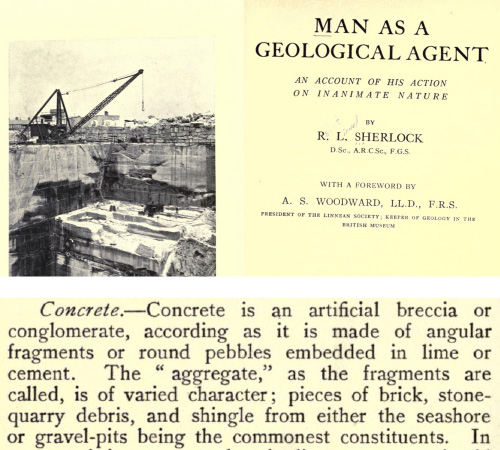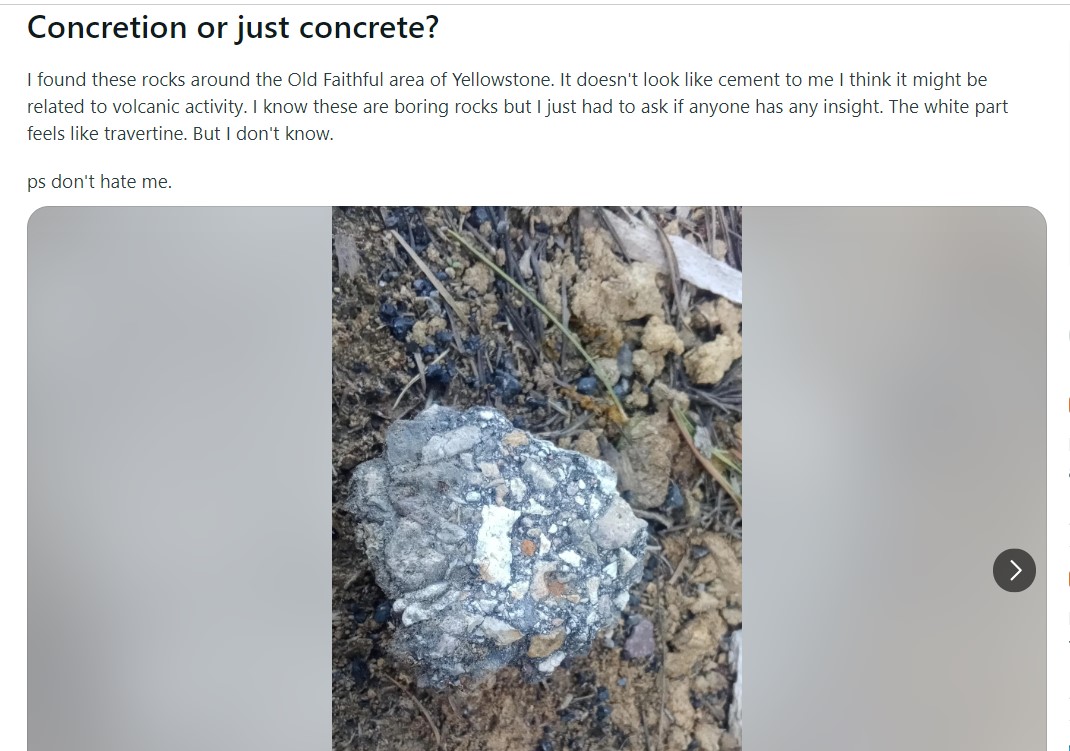We insist you listen to the polyphony of concrete communities!
Contributors
0 • Patchwork
You don’t ask a brick “what it wants to do”,1 a brick is not a single entity. Stabilised earth assemblages used throughout architecture (such as concrete panels, rammed earth walls, and even Kahn’s brick arch) contain multitudes—rocks, minerals, sediment, water flows, chemical reactions, bacterium, gasses, and earthly critters—that sometimes work in common and other times at crossed purposes.
Remember, not all voices speak as one, or on demand. But we invite you to listen transversely, against the grain.
Here is a story told simultaneously by writers and rocks and other elements, in order that we might consider how to work with concrete in common.
Concrete assembles itself from ingredients made mobile. Substances excavated from distanced sites and tumbled in mixers, this is a material that is highly animated and travels far. Humans become rock-makers unknowingly: geological agents without the wherewithal of their agency. And, once concrete reaches its end of life as a building, it achieves a new kind of “vitality” that is complicated and troubling.2
This isn’t a new observation.
ALUMINUM OXIDE (Al2O3)
Let us tell you what we see in concrete—nothing. Only weak bits of the earth: loosened and the worst of in-between states. It is nothing without our power. We settle in and resist all change.
We think the work of British geologist Robert Lionel Sherlock (1875-1948) provides illumination. In the early twentieth century, Sherlock traveled the United Kingdom, in an attempt to calculate the impact humans had on reshaping the earth’s surface there.
SILICON DIOXIDE (SiO2)
They think of us as a mass of individual elements—humans say ‘like so many grains of sand’—but we are more than plural; we are innumerable! We sweep round the planet through vast ocean currents, the force of bulldozers, and a child’s hand making castles. You cannot contain us.
After years of field investigations, Sherlock published ‘Man as a Geological Agent: An Account of His Action on Inanimate Nature’ in 1922 (see Figure 01). The date is important because Sherlock’s work is startlingly relevant and prescient, even a hundred years later.
Through his work Sherlock explored how humans altered terrains, geological strata, and the Earth’s atmosphere through the making of cities, and agricultural and industrial landscapes. He attempted to calculate and measure the material moved: an impossible ambitious goal.
Sherlock identified humans as increasingly powerful geological forces, shaping the planet’s surface through activities that mimicked geological events. Using the city as a case study, Sherlock observed London rising on its own waste, amongst the street sweepings, debris and sludge was building rubble, glass, bricks, and concrete. Accreting as new strata, he estimated, an extra foot every century.3
CALCIUM OXIDE (CaO)
We have our own agency: we alone create energy. Sometimes we work, sometimes we don’t. We will choose when. You will wait on us.
Not only did humans mimic natural geological processes, but Sherlock observed them making materials that replicated naturally occurring rocks: glass, bricks, and, of course, concrete, which Sherlock likened to a kind of breccia.4 Time is important here: geological processes operate across millenia and their transformations can be imperceptible to the human eye—let alone human control.
IRON OXIDE (Fe2O3)
You laughed at us as rust and now look: we bring your sad earth to bloom. No fade, no weather is our match, we will never disappear into the void. You think us decorative at best but we’ll outlast you all.
Let’s move ourselves a hundred years forward to examine other stories that offer alternatives to concrete as a stable material. This one comes from 2021, when artist Zosia Dzierżawska and architect Charlotte Malterre-Barthes published a graphic novel imagining a future global moratorium on demolition and new construction, as per Figure 02. In their collaborative publication, the authors propose new roles for built industry workers—maintaining and caring for buildings rather than making them—such as “material nurses” and “building surgeons”.5 We think these are interesting voices to retell our world because such caretakers give a counterpoint to roles already assigned to us architects as rock-makers and geological agents.
WATER (H2O)
You use me with abandon, never thinking I might not be there. But what now? What is left of me? The more you take, the more grievances my memory stores. Remember: I can take it all down with a single wave. Alas, what have you done?
So too, an online forum (see Figure 03) illustrates the ambiguity we find ourselves in: unable to identify concrete from rock or, importantly, assign different values to each. But have we really listened to this polyphony? Can we distinguish between the two? What would change if we could? What if we look to sediments, flows, aggregates, and other entities that instead articulate relations amongst the two? This is more closely kinned with Gregory Bateson’s discussion of our shared knowledge of the world: “In the pronoun we, I of course included the starfish and the redwood forest, the segmenting egg, and the Senate of the United States”.6 We could all be counted amongst the innumerable.
This understanding of concrete—recognising it as a community of volatile changeable elements—highlights myriad questions we might pose around this material, its past and present usage, and extended and unpredictable future.
GYPSUM (CaSO4.2H2O)
We come from the deep seabed and can extinguish fire. We slow down everything, control everything. We are the ‘becoming’ in ‘always-becoming’ and manage all to work together for longer: human, mineral, rock, and others as one.
We ask you to listen closely to the long histories and possible futures of these communities and acknowledge their agency as we work to shore up this world together. Just like concrete, we are not stable—but here, in a profusion of voices, we call out an emancipation from the lies that others tell on our behalf.

Figure 01: An excerpt on concrete from ‘Man as a Geological Agent: An Account of His Action on Inanimate Nature’ (Sherlock, 1922).

Figure 02: Extract from Zosia Dzierżawska & Charlotte Malterre-Barthes’ ‘Architecture Without Extraction’.

Figure 03: Recent reddit discussion trying to confirm whether an object is concrete or rock (https://www.reddit.com/r/geology/comments/13x5vcl/concretion_or_just_concrete, 2023)
REFERENCES
Bateson, Gregory. Mind and Nature: A Necessary Unity. New York: E.P. Dutton, 1979.
Bennett, Jane. Vibrant Matter : A Political Ecology of Things. Durham : Duke University Press, 2010. Online: http://ezproxy.uws.edu.au/login?url=http://site.ebrary.com/lib/sydney/Top?layout=document&id=10393339.
Dzierżawska, Zosia & Charlotte Malterre-Barthes. Architecture Without Extraction. London: Architectural Review, 2021. Online: https://www.zozozosia.com/portfolios/architecture-without-extraction
My Architect: A Son’s Journey directed by Nathaniel Kahn. 2003; Mediaworks, DVD.
Sherlock, Robert Lionel. Man As A Geological Agent: An Account Of His Actions On Inanimate Nature. London: H. F. & G. Witherby, 1922. Online: https://archive.org/details/manasgeologicala00sheriala/page/n8/mode/1up?ref=ol&view=theater.
Sherlock, Robert Lionel. “The Influence of Man as an Agent in Geographical Change.” The Geographical Journal 61, no. 4 (1923): 258–68.
R-geology. Concretion or just concrete? Reddit forum, 2023. Online: https://www.reddit.com/r/geology/comments/13x5vcl/concretion_or_just_concrete/
- Louis Kahn, during a 1971 University of Pennsylvania masterclass with architecture students, quoted in My Architect: A Son’s Journey directed by Nathaniel Kahn (2003). Mediaworks, DVD. ↩︎
- Bennett, “Vibrant Matter : A Political Ecology of Things.” ↩︎
- Sherlock, Robert Lionel “The Influence of Man as an Agent in Geographical Change,” The Geographical Journal 61, no. 4 (1923): 263. ↩︎
- Breccia is a significant sedimentary rock within the field of geology. Commonly found in alluvial deposits, impact craters, and along fault lines, it is constituted by a series of angular rock fragments of often wildly varying sizes and clays cemented together, preserving forever a visible matrix of historical information about its own formation. ↩︎
- Dzierżawska, Zosia & Charlotte Malterre-Barthes. Architecture Without Extraction. (London: Architectural Review, 2021), p. 4. ↩︎
- Bateson, Gregory. Mind and Nature: A Necessary Unity. (New York: E.P. Dutton, 1979), p. 17. ↩︎